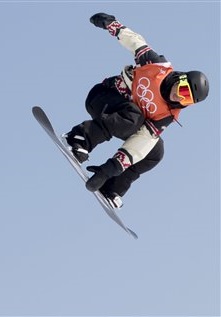2018 Winter Olympics: Snowboarding


Parallel slalom gives way to big air

Related Links
Snowboarding, a largely American sport made popular by events like the X-games, is a fairly recent addition to the Olympics. Snowboarding makes its sixth Olympic appearance at Pyeongchang. The sport, which first appeared at the 1998 Nagano Games, is still a work in progress as events are changed and added. For the 2018 Games, the parallel slalom will be substituted with the new big air event.
The events
With the big air events, there are 10 snowboarding events: men's and women's halfpipe, men's and women's parallel giant slalom, men's and women's snowboard cross, men's and women's slopestyle, and men's and women's big air.
Slopestyle, set on a downhill course, combines aerial tricks and stunts performed on boxes and rails. Riders are not timed; instead they are scored for the difficulty and style of their tricks.
In snowboard cross, the course is made up of different sections: whoops (moguls), waves, banks, kickers, and spines (jumps with 90° angles), with a series of blue and red gates and triangular flags marking the course and indicating entrances to obstacles.
The half-pipe is probably the most excitng snowboarding event to watch. Athletes perform acrobatic, aerial twists and turns high above the rim of the half-pipe. In the half-pipe, each run is scored on a scale of 0.1 to 10.0 by a panel of five judges. One judge scores the standardized moves, another scores amplitude (the height of maneuvers), one scores quality of rotations, and two score overall impression. For the amplitude score, each maneuver is given an additional point for every 30 centimeters that the competitor reaches above the lip of the pipe. The scores for each maneuver are averaged to determine the final amplitude score. Falls and other mistakes lead to deductions.
In the parallel giant slalom, the racers take qualifying runs down a course, making turns around gates. The top 16 men and top 16 women are ranked according to their times. Then they face off in a bracket format with 1 against 16, 2 against 15, etc. The two snowboarders compete in a two-race match (once on each course). The winner is the racer who posts the best total time. The winners of each match move on to the next round until the semifinals. The two semifinals winners race for the gold (the loser gets the silver) and the semifinals losers race for the bronze.
The big air event, which replaces the parallel slalom, is about making the most out of one's jumps. The goal is for snowboarders to perform as many jumps as possible during the allotted time, completing flips and spins as they fly off the ramps. Scoring is similar
The Pyeongchang Games
The snowboarding events will be held at Phoenix Snow Park and at the Alpensia Ski Jumping Centre (at the Alpensia Resort) in Pyeonchang. The events will begin with the men's slopestyle on Feb. 11, and will conclude with the men's parallel giant slalom on Feb. 24.
More about the 2018 Winter Olympics
